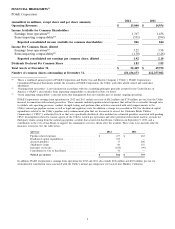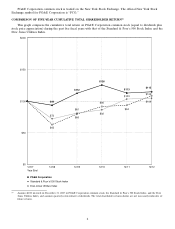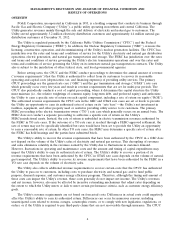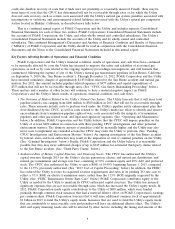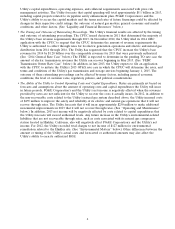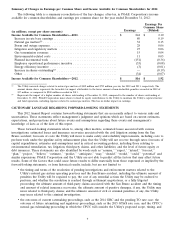PG&E 2012 Annual Report Download - page 12
Download and view the complete annual report
Please find page 12 of the 2012 PG&E annual report below. You can navigate through the pages in the report by either clicking on the pages listed below, or by using the keyword search tool below to find specific information within the annual report.cost recovery mechanisms that will apply to the second phase of the pipeline safety enhancement plan; and
the outcomes of other ratemaking and regulatory proceedings;
• the ultimate amount of costs the Utility incurs in the future that are not recovered through rates, including
costs to perform work under the pipeline safety enhancement plan, to identify and remove encroachments
from transmission pipeline easements, and to perform incremental work to improve the safety and reliability
of electric and natural gas operations;
• the outcome of future investigations or proceedings that may be commenced by the CPUC or other regulatory
authorities relating to the Utility’s compliance with laws, rules, regulations, or orders applicable to the
operation, inspection, and maintenance of its electric and gas facilities;
• whether PG&E Corporation and the Utility are able to repair the reputational harm that they have suffered,
and may suffer in the future, due to the negative publicity surrounding the San Bruno accident, the related
civil litigation, and the pending investigations, including any charge or finding of criminal liability;
• the level of equity contributions that PG&E Corporation must make to the Utility to enable the Utility to
maintain its authorized capital structure as the Utility incurs charges and costs, including costs associated with
natural gas matters and penalties imposed in connection with the pending investigations, that are not
recoverable through rates or insurance;
• the impact of environmental remediation laws, regulations, and orders; the ultimate amount of costs incurred
to discharge the Utility’s known and unknown remediation obligations; the extent to which the Utility is able
to recover compliance and remediation costs from third parties or through rates or insurance; and the
ultimate amount of costs the Utility incurs in connection with environmental remediation liabilities that are
not recoverable through rates or insurance, such as the remediation costs associated with the Utility’s natural
gas compressor station site located near Hinkley, California;
• the impact of new legislation or NRC regulations, recommendations, policies, decisions, or orders relating to
the operations, seismic design, security, safety, or decommissioning of nuclear facilities, including the Utility’s
Diablo Canyon nuclear power plant (‘‘Diablo Canyon’’), or relating to the storage of spent nuclear fuel,
cooling water intake, or other issues; and the ability of the Utility to relicense the Diablo Canyon units;
• the impact of weather-related conditions or events (such as storms, tornadoes, floods, drought, solar or
electromagnetic events, and wildland and other fires), natural disasters (such as earthquakes, tsunamis, and
pandemics), and other events (such as explosions, fires, accidents, mechanical breakdowns, equipment failures,
human errors, and labor disruptions), as well as acts of terrorism, war, or vandalism, including cyber-attacks,
that can cause unplanned outages, reduce generating output, disrupt the Utility’s service to customers, or
damage or disrupt the facilities, operations, or information technology and systems owned by the Utility, its
customers, or third parties on which the Utility relies; and subject the Utility to third-party liability for
property damage or personal injury, or result in the imposition of civil, criminal, or regulatory penalties on the
Utility;
• the impact of environmental laws and regulations aimed at the reduction of carbon dioxide and other
greenhouse gases (‘‘GHG’’s), and whether the Utility is able to recover associated compliance costs, including
the cost of emission allowances and offsets, that the Utility may incur under cap-and-trade regulations;
• changes in customer demand for electricity (‘‘load’’) and natural gas resulting from unanticipated population
growth or decline in the Utility’s service area, general and regional economic and financial market conditions,
the extent of municipalization of the Utility’s electric distribution facilities, changing levels of ‘‘direct access’’
customers who procure electricity from alternative energy providers, changing levels of customers who
purchase electricity from governmental bodies that act as ‘‘community choice aggregators,’’ and the
development of alternative energy technologies including self-generation and distributed generation
technologies;
• the adequacy and price of electricity, natural gas, and nuclear fuel supplies; the extent to which the Utility can
manage and respond to the volatility of energy commodity prices; the ability of the Utility and its
counterparties to post or return collateral in connection with price risk management activities; and whether
the Utility is able to recover timely its energy commodity costs through rates;
• whether the Utility’s information technology, operating systems and networks, including the advanced metering
system infrastructure, customer billing, financial, and other systems, can continue to function accurately while
8





